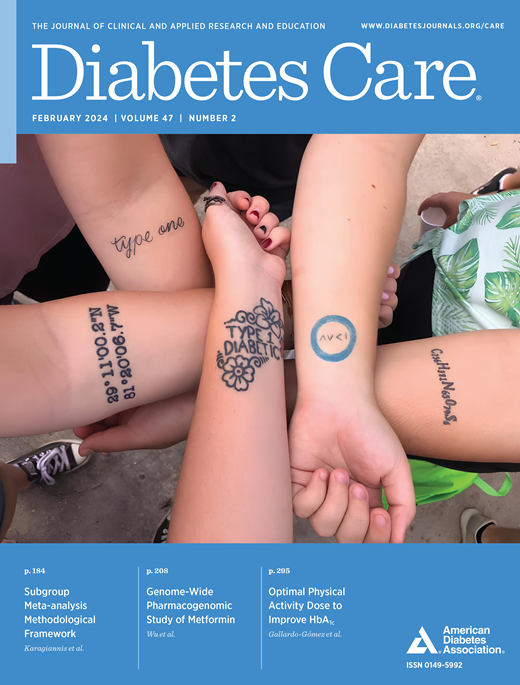真实世界中使用智能胰岛素笔的糖尿病患者坚持治疗与连续血糖监测结果之间的关系
IF 14.8
1区 医学
Q1 ENDOCRINOLOGY & METABOLISM
引用次数: 0
摘要
目的 使用来自 16 个国家的真实数据,评估使用智能胰岛素笔(NovoPen 6 或 NovoPen Echo Plus)和连续血糖监测仪(CGM)自我注射德谷胰岛素和胰岛素栓的成人胰岛素注射依从性、智能胰岛素笔参与度和血糖控制的相关性。研究设计与方法 14 天内的数据汇总。治疗依从性根据漏服基础胰岛素和漏服胰岛素剂量的次数来定义,智能笔参与度根据上传数据的天数来定义。结果 分析了 3,945 名成人的数据,其中包括 25,157 个 14 天的数据,CGM 覆盖率≥70%。平均而言,14 天内遗漏了 0.2 次基础胰岛素剂量和 6.0 次胰岛素注射剂量。在 14 天内至少错过一次基础胰岛素剂量的估计概率为 17.6%(95% CI 16.5,18.7)。每 14 天错过一次胰岛素基础剂量或胰岛素注射剂量与血糖水平在范围内(TIR)(3.9-10.0 mmol/L)的时间百分比显著下降有关,分别为-2.8%(95% CI -3.7,-1.8)和-1.7%(-1.8,-1.6);因此,错过两次胰岛素基础剂量或四次胰岛素注射剂量将使 TIR 下降 >5%。智能笔的使用与血糖结果呈正相关。结论 对真实世界中智能笔和 CGM 数据的综合分析表明,在 14 天内错过两次基础胰岛素剂量或四次胰岛素注射剂量将与 TIR 的临床相关性下降有关。智能胰岛素笔为了解治疗注射行为提供了宝贵的信息。本文章由计算机程序翻译,如有差异,请以英文原文为准。
Association Between Treatment Adherence and Continuous Glucose Monitoring Outcomes in People With Diabetes Using Smart Insulin Pens in a Real-World Setting
OBJECTIVE To evaluate the association of insulin injection adherence, smart insulin pen engagement, and glycemic control using real-world data from 16 countries from adults self-administering basal insulin degludec and bolus insulin with a smart insulin pen (NovoPen 6 or NovoPen Echo Plus) alongside continuous glucose monitoring (CGM). RESEARCH DESIGN AND METHODS Data were aggregated over 14-day periods. Treatment adherence was defined according to the number of missed basal and missed bolus insulin doses and smart pen engagement according to the number of days with data uploads. RESULTS Data from 3,945 adults, including 25,157 14-day periods with ≥70% CGM coverage, were analyzed. On average, 0.2 basal and 6.0 bolus insulin doses were missed over 14 days. The estimated probability of missing at least one basal insulin dose over a 14-day period was 17.6% (95% CI 16.5, 18.7). Missing one basal or bolus insulin dose per 14 days was associated with a significant decrease in percentage of time with glucose levels in range (TIR) (3.9–10.0 mmol/L), of −2.8% (95% CI −3.7, −1.8) and −1.7% (−1.8, −1.6), respectively; therefore, missing two basal or four bolus doses would decrease TIR by >5%. Smart pen engagement was associated positively with glycemic outcomes. CONCLUSIONS This combined analysis of real-world smart pen and CGM data showed that missing two basal or four bolus insulin doses over a 14-day period would be associated with a clinically relevant decrease in TIR. Smart insulin pens provide valuable insights into treatment injection behaviors.
求助全文
通过发布文献求助,成功后即可免费获取论文全文。
去求助
来源期刊

Diabetes Care
医学-内分泌学与代谢
CiteScore
27.80
自引率
4.90%
发文量
449
审稿时长
1 months
期刊介绍:
The journal's overarching mission can be captured by the simple word "Care," reflecting its commitment to enhancing patient well-being. Diabetes Care aims to support better patient care by addressing the comprehensive needs of healthcare professionals dedicated to managing diabetes.
Diabetes Care serves as a valuable resource for healthcare practitioners, aiming to advance knowledge, foster research, and improve diabetes management. The journal publishes original research across various categories, including Clinical Care, Education, Nutrition, Psychosocial Research, Epidemiology, Health Services Research, Emerging Treatments and Technologies, Pathophysiology, Complications, and Cardiovascular and Metabolic Risk. Additionally, Diabetes Care features ADA statements, consensus reports, review articles, letters to the editor, and health/medical news, appealing to a diverse audience of physicians, researchers, psychologists, educators, and other healthcare professionals.
 求助内容:
求助内容: 应助结果提醒方式:
应助结果提醒方式:


